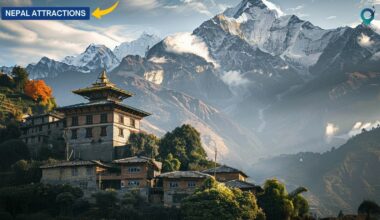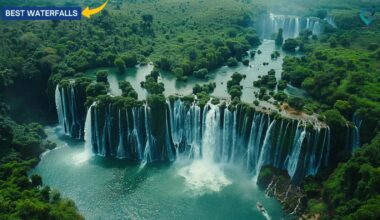17 Top-Rated Attractions & Places to Visit in Switzerland (Expert Travel Guide 2025)
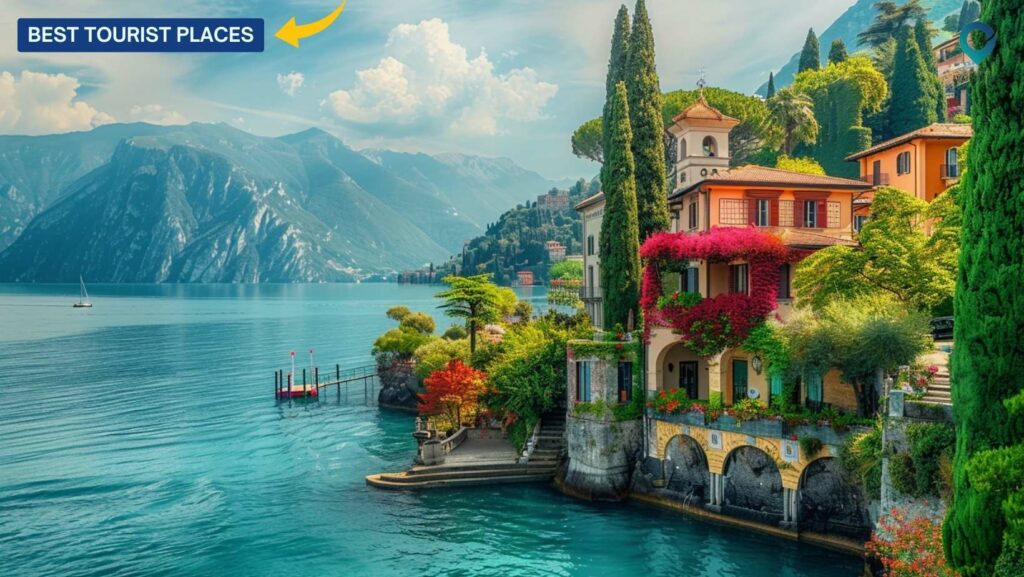
Are you ready to explore some of the most famous places around the world in 2024? From the beautiful beaches of Bora Bora to the ancient ruins of Petra and the vibrant cityscape of Dubai, this list covers destinations that offer incredible experiences.

Whether you dream of relaxing in the luxury of the Maldives or challenging yourself with the heights of Mount Everest, each place has its unique charm. Join us as we discover 22 must-visit locations that promise unforgettable adventures and memories. This is your ultimate guide to the top world-famous places you should visit in 2024.
1. Taj Mahal – Stunning marble mausoleum
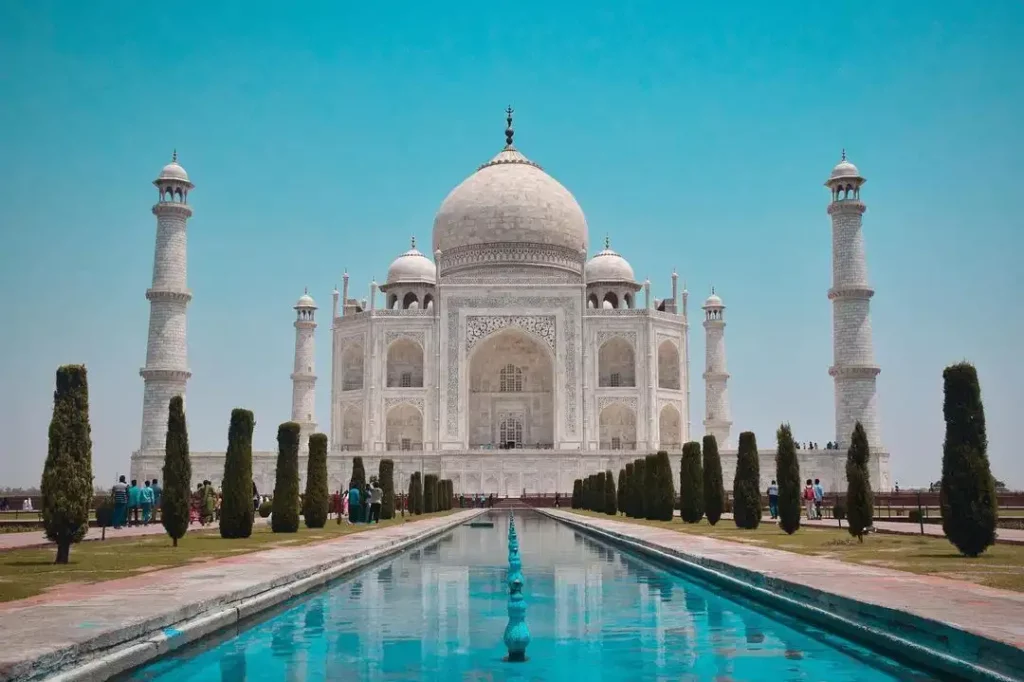
About the place: The Taj Mahal is a breathtaking marble mausoleum located in Agra, India. It was built by the Mughal emperor Shah Jahan in memory of his beloved wife Mumtaz Mahal. This iconic monument is renowned worldwide for its stunning architecture and romantic history. 🕌
Place Address: Dharmapuri, Forest Colony, Tajganj, Agra, Uttar Pradesh 282001, India
How to get there:
- By Air: The nearest airport is the Agra Airport (AGR), about 13 km away. From the airport, you can take a taxi or a pre-booked car to reach the Taj Mahal.
- By Train: Agra is well-connected by train. The Agra Cantonment Railway Station (AGC) is the main station. From there, you can hire a taxi or take a local bus to reach the Taj Mahal.
- By Road: Agra is well-connected by roadways. You can take a bus, hire a taxi, or drive your vehicle. The Taj Mahal is easily accessible from major cities like Delhi, Jaipur, and Lucknow via well-maintained highways.
Why to visit: Visiting the Taj Mahal is a must for anyone interested in history, architecture, or romance. It’s not just a beautiful building but also a symbol of eternal love and a UNESCO World Heritage Site. Witnessing its grandeur in person is an unforgettable experience. 🌟
Daily Average Budget:
- Entry Fee: Approximately INR 1300 for foreign tourists and INR 50 for Indian nationals.
- Guided Tours: Varies but around INR 2500 onwards for a comprehensive tour.
- Food and Souvenirs: Budget around INR 500-1000 per day depending on your preferences.
Activities and Attractions:
- Marvel at the stunning marble architecture and intricate carvings.
- Take memorable photos at the iconic viewpoint.
- Visit the adjacent Taj Museum for historical insights.
- Explore the serene gardens surrounding the Taj Mahal.
- Enjoy a boat ride on the Yamuna River for a different perspective.
Things to Avoid:
- Photography inside the main mausoleum is prohibited.
- Avoid visiting during peak tourist hours to enjoy a more peaceful experience.
- Beware of unauthorized guides and vendors outside the monument.
- Respect local customs and guidelines, especially in religious areas.
2. Great Wall of China – Ancient defensive fortification

About the place: The Great Wall of China is an ancient defensive structure stretching over 13,000 miles across northern China. It was built and rebuilt between the 5th century BC and the 16th century to protect Chinese states and empires from invasions and raids by nomadic groups and military incursions. This remarkable feat of ancient engineering and construction is a testament to China’s rich history and strategic defense planning. 🏯
Place Address: Mutianyu, Huairou District, Beijing, China
How to get there:
- By Air: The nearest major airport is Beijing Capital International Airport (PEK). From there, you can take a taxi or hire a car to reach the Great Wall.
- By Train: Beijing is well-connected by high-speed trains from major cities in China. From Beijing, you can take a bus, taxi, or join a tour to visit the Great Wall.
- By Road: The Great Wall is accessible by road from Beijing. You can drive, take a bus, or hire a taxi to reach different sections of the wall.
Why to visit: Visiting the Great Wall of China offers a glimpse into ancient Chinese history and culture. It’s not only an architectural marvel but also a symbol of China’s enduring strength and strategic foresight. Walking along its ancient stones provides a sense of awe and wonder at the scale and ingenuity of human achievement. 🌄
Daily Average Budget:
- Entry Fee: Varies by section but generally around CNY 60-150 per person.
- Guided Tours: Optional but recommended for historical insights; prices vary.
- Food and Souvenirs: Budget around CNY 100-200 per day depending on your preferences.
Activities and Attractions:
- Walk along the ancient walls and towers, enjoying panoramic views of the Chinese countryside.
- Explore the watchtowers and fortifications that once guarded the northern frontier.
- Visit the Great Wall Museum for historical artifacts and insights into its construction.
- Take a cable car or hike to different sections for varying views and experiences.
- Capture stunning photos of the wall winding through the mountains and valleys.
Things to Avoid:
- Climbing on unstable sections of the wall for safety reasons.
- Overestimating your physical capabilities; some sections involve steep climbs and uneven terrain.
- Buying from unauthorized vendors; stick to official ticketing and guided tour services.
- Littering or damaging the historical structure; respect the cultural significance of the Great Wall.
3. Eiffel Tower – Iconic iron lattice structure
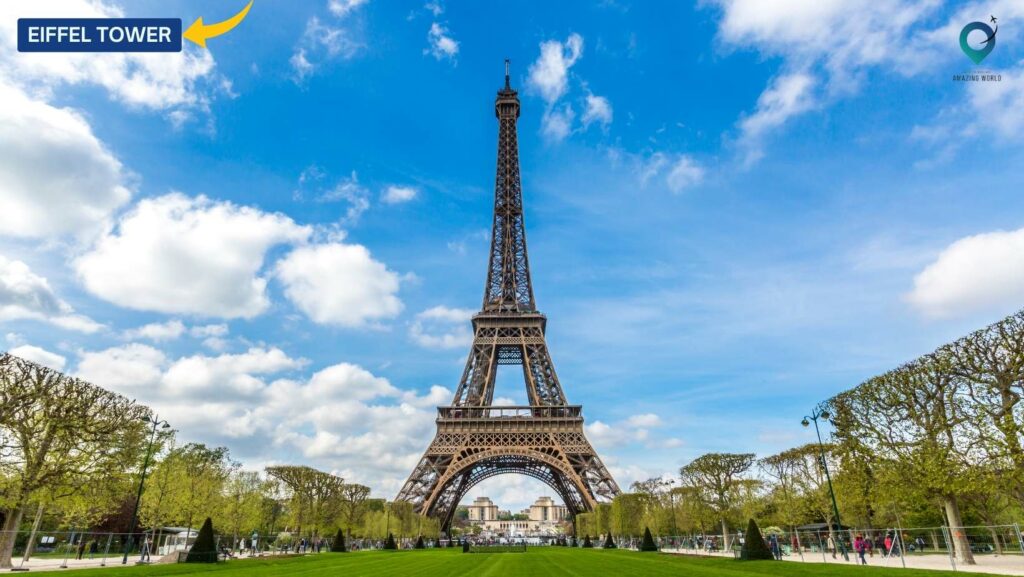
About the place: The Eiffel Tower is an iconic iron lattice tower located in Paris, France. Built-in 1889 as the entrance arch to the 1889 World’s Fair, it has since become a global cultural icon of France and one of the most recognizable structures in the world. Standing at 324 meters tall, the Eiffel Tower offers breathtaking views of Paris and attracts millions of visitors annually. 🗼
Place Address: Champ de Mars, 5 Avenue Anatole France, 75007 Paris, France
How to get there:
- By Air: The nearest major airport is Charles de Gaulle Airport (CDG). From there, you can take a taxi, airport shuttle, or train to central Paris and then use the Paris Metro to reach the Eiffel Tower.
- By Train: Paris is well-connected by trains from all over Europe. From Gare du Nord or other major train stations, you can easily reach the Eiffel Tower using the Paris Metro or local buses.
- By Road: You can drive to Paris and park in nearby parking facilities. Alternatively, take a taxi or use rideshare services to get directly to the Eiffel Tower.
Why to visit: Visiting the Eiffel Tower is a quintessential Parisian experience. It offers not only stunning views of the city but also a glimpse into French history and engineering excellence. Whether day or night, the Eiffel Tower’s beauty captivates visitors and serves as a symbol of romance and architectural ingenuity. 🌟
Daily Average Budget:
- Entry Fee: Varies by access level (elevator or stairs) but generally around EUR 10-25 per person.
- Guided Tours: Available for deeper insights into the tower’s history and construction; prices vary.
- Food and Souvenirs: Budget around EUR 20-50 per day depending on dining preferences and souvenir shopping.
Activities and Attractions:
- Take an elevator ride to the top for panoramic views of Paris.
- Dine at one of the tower’s restaurants for a memorable culinary experience.
- Visit the first and second floors for exhibitions and historical displays.
- Enjoy picnicking or strolling in the nearby Champ de Mars park.
- Capture stunning photos of the tower against different backdrops throughout the day.
Things to Avoid:
- Long queues during peak tourist hours; consider visiting early morning or late afternoon for a more relaxed experience.
- Unauthorized street vendors selling cheap souvenirs around the tower.
- Climbing or attempting to access restricted areas without permission.
- Avoiding scammers or pickpockets, especially in crowded areas around the tower.
4. Statue of Liberty – Symbolic neoclassical sculpture

About the place: The Statue of Liberty is a symbolic neoclassical sculpture located on Liberty Island in New York Harbor. It was a gift from France to the United States and was dedicated in 1886. Designed by Frédéric Auguste Bartholdi, the statue represents freedom and democracy, welcoming immigrants and visitors to America. With its iconic torch held high, it stands as a beacon of hope and a testament to the enduring values of liberty and justice. 🗽
Place Address: Liberty Island, New York, NY 10004, USA
How to get there:
- By Air: The nearest major airports are John F. Kennedy International Airport (JFK) and Newark Liberty International Airport (EWR). From there, take a taxi, airport shuttle, or public transportation to Battery Park or Liberty State Park, where ferries depart for Liberty Island.
- By Train: Take a train to New York Penn Station or Newark Penn Station, then transfer to the subway or local transportation to Battery Park or Liberty State Park.
- By Road: Drive to Battery Park in Manhattan or Liberty State Park in New Jersey and park in nearby parking facilities. From there, take a ferry to Liberty Island.
Why to visit: Visiting the Statue of Liberty offers a chance to experience American history and iconic symbolism firsthand. From learning about its construction to admiring the panoramic views of Manhattan and New York Harbor from the pedestal or crown, visitors gain a deeper appreciation for liberty, diversity, and the American dream. 🌟
Daily Average Budget:
- Entry Fee: Includes ferry and access to Liberty Island and Ellis Island; around USD 25-30 per person.
- Guided Tours: Available for detailed insights into the statue’s history and significance; prices vary.
- Food and Souvenirs: Budget around USD 20-50 per day depending on dining choices and souvenir purchases.
Activities and Attractions:
- Explore Liberty Island and visit the Statue of Liberty Museum for exhibits on its history and construction.
- Climb up to the pedestal or even higher to the crown for stunning views of New York City.
- Take a guided tour to learn about the statue’s role as a symbol of freedom and its cultural impact.
- Enjoy a picnic or stroll along the waterfront promenade with views of Manhattan skyline.
- Capture memorable photos with Lady Liberty as a backdrop.
Things to Avoid:
- Long wait times for ferry tickets and security checks during peak tourist seasons; consider booking tickets in advance.
- Climbing the statue without proper reservations and safety precautions.
- Buying from unauthorized vendors; stick to official ticketing and tour services.
- Littering or damaging the island’s natural and historical features; respect the environment and cultural heritage.
5. Machu Picchu – Ancient Incan citadel
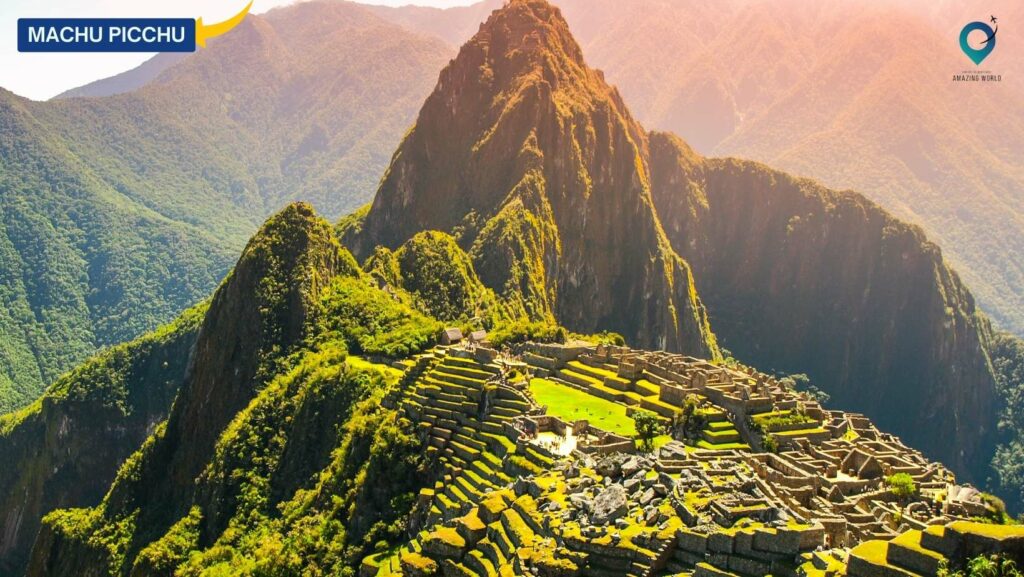
About the place: Machu Picchu is an ancient Incan citadel located high in the Andes Mountains of Peru. Built in the 15th century and later abandoned, it was rediscovered in 1911 by archaeologist Hiram Bingham. This UNESCO World Heritage site is renowned for its sophisticated dry-stone walls, stunning terraces, and panoramic views of the surrounding mountains and Urubamba River valley. It remains a testament to the ingenuity and advanced engineering skills of the Incan civilization. 🏞️
Place Address: Machu Picchu, 08680, Peru
How to get there:
- By Air: The nearest major airport is Alejandro Velasco Astete International Airport (CUZ) in Cusco, Peru. From Cusco, you can take a train or bus to Aguas Calientes (Machu Picchu Pueblo), the gateway to Machu Picchu.
- By Train: Board a scenic train from Cusco or Ollantaytambo to Aguas Calientes. From there, take a bus up to Machu Picchu or hike along the Inca Trail to reach the citadel.
- By Road: Drive or take a bus from Cusco to Ollantaytambo, then board a train to Aguas Calientes. From Aguas Calientes, take a bus or hike up to Machu Picchu.
Why to visit: Visiting Machu Picchu offers a profound cultural and historical experience. It allows visitors to step back in time and explore the mysterious ruins of an ancient civilization nestled amidst breathtaking natural landscapes. Whether trekking the Inca Trail or exploring the citadel’s intricate stone structures, Machu Picchu captivates with its beauty, history, and spiritual significance. 🌄
Daily Average Budget:
- Entry Fee: Includes access to Machu Picchu; around PEN 152-200 (USD 45-60) per person depending on peak season.
- Guided Tours: Highly recommended for insights into Incan history and architecture; prices vary.
- Accommodation and Meals: Budget around PEN 100-300 (USD 30-90) per day depending on lodging choices and dining preferences.
Activities and Attractions:
- Explore the ancient ruins of Machu Picchu, including the Temple of the Sun, Intihuatana stone, and agricultural terraces.
- Hike the famous Inca Trail or alternative routes like the Salkantay Trek for scenic views and cultural immersion.
- Visit the Machu Picchu Museum in Aguas Calientes for artifacts and historical context.
- Take panoramic photos of Machu Picchu from vantage points like the Sun Gate (Inti Punku) or Huayna Picchu mountain.
- Experience the spiritual energy of Machu Picchu during sunrise or sunset, known for its transformative beauty.
Things to Avoid:
- Climbing on or touching fragile archaeological structures; respect preservation efforts.
- Overestimating physical abilities; acclimate to high altitude conditions before hiking or exploring.
- Purchasing from unauthorized vendors; support local businesses and licensed tour operators.
- Leaving trash or disrupting the natural environment; practice responsible tourism and leave no trace.
6. Pyramids of Giza – Majestic ancient tombs
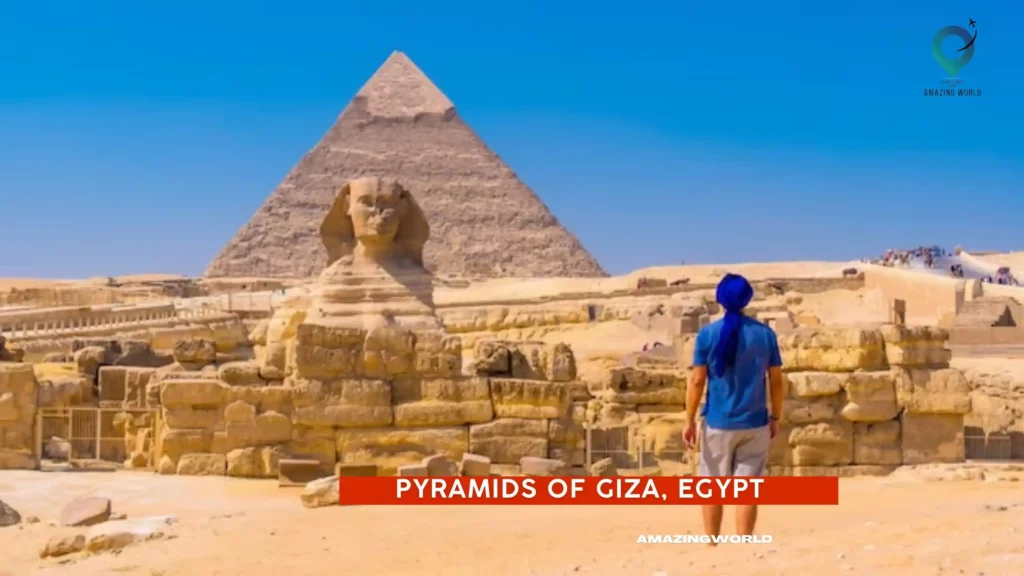
About the place: The Pyramids of Giza are majestic ancient tombs located on the outskirts of Cairo, Egypt. Built over 4,500 years ago during the Old Kingdom period of ancient Egyptian history, these monumental structures include the Great Pyramid of Giza, the Pyramid of Khafre, and the Pyramid of Menkaure. They were constructed as royal tombs for pharaohs and are renowned for their massive size, precise engineering, and historical significance. 🏛️
Place Address: Giza Plateau, Al Haram, Giza Governorate, Egypt
How to get there:
- By Air: Fly into Cairo International Airport (CAI). From there, take a taxi or shuttle to the Giza Plateau.
- By Train: Take a train to Giza Station from Cairo’s main railway station. From Giza Station, hire a taxi or take a bus to the Giza Plateau.
- By Road: Drive or take a taxi from downtown Cairo to the Giza Plateau. There are also local buses and microbuses available from various points in Cairo to Giza.
Why to visit: Visiting the Pyramids of Giza offers a glimpse into ancient Egyptian civilization and its architectural marvels. These iconic structures symbolize the ingenuity and spiritual beliefs of the pharaohs, showcasing their eternal quest for immortality. Whether exploring the pyramids’ interior chambers, admiring the Sphinx, or taking in panoramic views of the desert landscape, the Pyramids of Giza inspire awe and fascination. 🌟
Daily Average Budget:
- Entry Fee: Includes access to the Giza Plateau and the Great Pyramid; around EGP 200-400 (USD 12-25) per person depending on chosen sites and access.
- Guided Tours: Recommended for insights into ancient Egyptian history and pyramid construction; prices vary.
- Food and Refreshments: Budget around EGP 100-200 (USD 6-12) per day for meals and snacks.
Activities and Attractions:
- Explore the interior of the Great Pyramid and other pyramids open to visitors.
- Take a camel ride or horse-drawn carriage tour around the Giza Plateau.
- Visit the Solar Boat Museum to see an ancient Egyptian boat used for pharaohs’ journeys to the afterlife.
- Watch the Sound and Light Show at the Pyramids for a dramatic retelling of their history.
- Capture photos of the pyramids against the backdrop of the Egyptian desert.
Things to Avoid:
- Climbing or touching the pyramid structures without permission; respect preservation efforts.
- Engaging with unauthorized tour guides; choose licensed guides for accurate historical information.
- Purchasing from unauthorized vendors; support local businesses and licensed souvenir shops.
- Disregarding local customs or regulations; follow guidelines for photography and behavior at archaeological sites.
7. Colosseum – Iconic ancient amphitheater
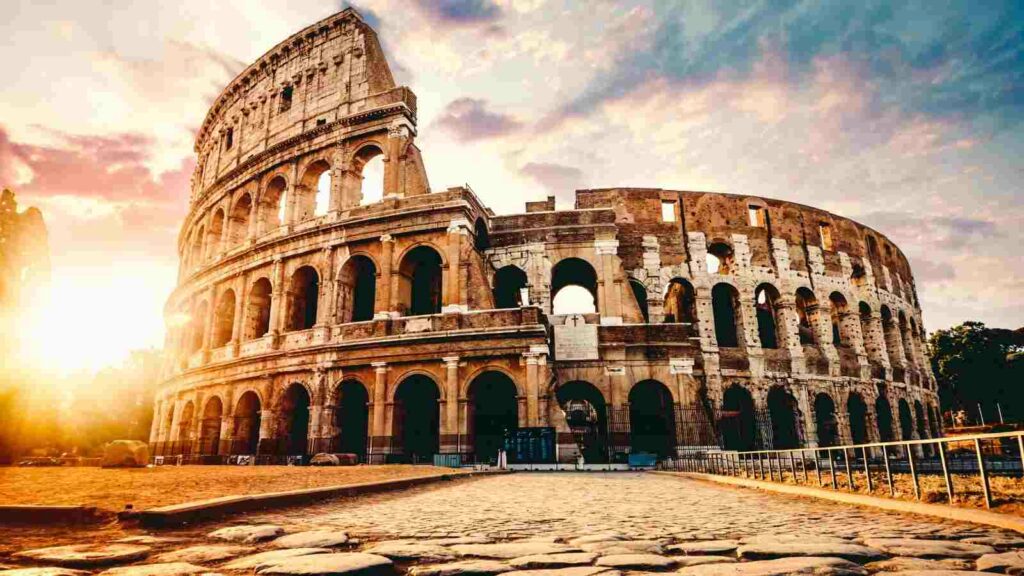
About the place: The Colosseum is an iconic ancient amphitheater located in the heart of Rome, Italy. Built between 70-80 AD during the Roman Empire, it was used for gladiatorial contests, public spectacles, and theatrical performances. This UNESCO World Heritage site is an architectural marvel, known for its elliptical shape and sophisticated engineering, allowing up to 80,000 spectators to witness various events. Today, it stands as a symbol of Roman ingenuity and cultural legacy. 🏟️
Place Address: Piazza del Colosseo, 1, 00184 Roma RM, Italy
How to get there:
- By Air: Fly into Leonardo da Vinci International Airport (FCO) or Ciampino Airport (CIA). From there, take a taxi or airport shuttle to central Rome.
- By Train: Arrive at Roma Termini, the main railway station in Rome. From Termini, take the metro Line B to Colosseo station or walk to the Colosseum area.
- By Metro: Take Line B (Blue Line) of the Rome Metro to Colosseo station, which is directly adjacent to the Colosseum.
Why to visit: Visiting the Colosseum offers a journey back in time to ancient Rome’s vibrant entertainment culture. From imagining gladiatorial battles to exploring the underground chambers where wild animals were kept, the Colosseum provides insights into Roman history, architecture, and social life. Its enduring legacy as a symbol of grandeur and spectacle makes it a must-see destination for history enthusiasts and travelers alike. 🌟
Daily Average Budget:
- Entry Fee: Includes access to the Colosseum, Roman Forum, and Palatine Hill; around EUR 16-20 per person depending on tour options and access.
- Guided Tours: Recommended for detailed historical context and access to restricted areas; prices vary.
- Food and Beverages: Budget around EUR 15-30 per day for dining near the Colosseum and exploring local cuisine.
Activities and Attractions:
- Explore the Colosseum’s interior, including the arena floor and underground hypogeum.
- Visit the nearby Roman Forum and Palatine Hill for additional insights into ancient Roman life and governance.
- Take panoramic photos of the Colosseum from viewpoints like the nearby Arch of Constantine.
- Attend evening events or guided tours for a unique perspective on the amphitheater’s history and architecture.
- Shop for souvenirs and artisanal products in the surrounding area of Rome’s historic center.
Things to Avoid:
- Purchasing tickets from unauthorized vendors outside the Colosseum; use official ticketing services or book in advance.
- Climbing on or touching ancient stone structures; respect preservation efforts and historical artifacts.
- Engaging with street vendors or unsolicited guides; choose licensed tour operators for reliable information.
- Disregarding local regulations or customs; follow guidelines for photography and behavior in archaeological sites.
8. Sydney Opera House – Distinctive modern performing arts venue

About the place: The Sydney Opera House is a distinctive modern performing arts venue located on Bennelong Point in Sydney, Australia. Designed by Danish architect Jørn Utzon and opened in 1973, it is renowned for its unique sail-like design and iconic presence on Sydney Harbour. The Opera House hosts a variety of performances, including opera, ballet, theater, and concerts, making it a cultural hub and symbol of artistic excellence in Australia. 🎭
Place Address: Bennelong Point, Sydney NSW 2000, Australia
How to get there:
- By Air: Fly into Sydney Kingsford Smith Airport (SYD). From there, take a taxi, airport shuttle, or the Airport Link train to Circular Quay. Walk or take a short ferry ride to reach the Opera House.
- By Train: Arrive at Circular Quay Station via Sydney’s suburban train network. From Circular Quay, it’s a short walk along the waterfront to the Opera House.
- By Ferry: Take a ferry from Circular Quay Wharf to Circular Quay or Manly Ferry Wharf to Circular Quay. The Opera House is within walking distance from Circular Quay.
Why to visit: Visiting the Sydney Opera House allows you to experience world-class performances in a stunning architectural setting. Whether attending a concert in one of its halls, dining at its waterfront restaurants with views of the Harbour Bridge, or taking a guided tour to learn about its history and design, the Opera House offers a memorable cultural experience. Its strategic location also provides panoramic views of Sydney Harbour and the city skyline. 🌟
Daily Average Budget:
- Guided Tours: Includes access to theaters, rehearsal spaces, and backstage areas; around AUD 40-50 per person depending on tour options.
- Performance Tickets: Prices vary based on the event and seating; book in advance for popular performances.
- Dining: Budget around AUD 30-50 per person for dining at Opera Kitchen or other onsite restaurants.
- Souvenirs and Gifts: Shop for unique Opera House-themed souvenirs and gifts at the onsite shops.
Activities and Attractions:
- Take a guided tour of the Sydney Opera House to explore its architecture and behind-the-scenes areas.
- Attend a performance at one of the Opera House’s theaters, such as the Concert Hall or Joan Sutherland Theatre.
- Enjoy panoramic views of Sydney Harbour and the Harbour Bridge from the Opera House’s forecourt.
- Dine at waterfront restaurants like Opera Bar or Bennelong Restaurant for a culinary experience with a view.
- Explore nearby attractions like the Royal Botanic Garden or take a ferry ride to Taronga Zoo.
Things to Avoid:
- Purchasing tickets from unauthorized vendors; use official Opera House ticketing services or authorized partners.
- Disrupting performances or guided tours; respect the quiet and decorum expected in cultural venues.
- Climbing or touching the Opera House’s exterior; admire the architecture from designated viewing areas.
- Engaging with unauthorized tour guides; choose official Opera House tours for accurate information and access.
9. Niagara Falls – Majestic waterfall on the border

About the place: Niagara Falls is a majestic waterfall located on the border between Ontario, Canada, and New York, USA. Comprising three waterfalls—Horseshoe Falls, American Falls, and Bridal Veil Falls—Niagara Falls is renowned for its impressive size, natural beauty, and power. It attracts millions of visitors each year who come to witness the cascading waters and experience the surrounding natural attractions and activities. 🌊
Place Address: Niagara Falls, Ontario, Canada / Niagara Falls, New York, USA
How to get there:
- By Air: Fly into Buffalo Niagara International Airport (BUF) in New York or Toronto Pearson International Airport (YYZ) in Ontario. From there, rent a car, take a shuttle, or use public transport to reach Niagara Falls.
- By Car: Drive from major cities like Toronto (approximately 1.5 hours), New York City (approximately 7 hours), or Buffalo (approximately 30 minutes).
- By Train/Bus: Via Amtrak or Greyhound services to Niagara Falls, NY or VIA Rail Canada to Niagara Falls, ON. From there, use local transportation or walk to reach the falls.
Why to visit: Visiting Niagara Falls offers a breathtaking encounter with one of the world’s most famous natural wonders. Whether aboard a boat tour like the Maid of the Mist, exploring nearby parks and trails, or enjoying panoramic views from observation points like Table Rock, Niagara Falls provides a memorable experience for nature lovers and adventurers alike. Its beauty and power make it a must-see destination for travelers of all ages. 🌟
Daily Average Budget:
- Maid of the Mist Boat Tour: Includes rain poncho and close-up views of the falls; around CAD 25-30 (USD 20-25) per person.
- Niagara Parks Adventure Pass: Includes access to attractions like Journey Behind the Falls and Niagara’s Fury; around CAD 65-75 per person.
- Dining: Budget around CAD 15-30 per person for meals at local restaurants or cafes.
- Parking and Transportation: Plan for parking fees or use local shuttle services for convenience.
Activities and Attractions:
- Take a boat tour on the Maid of the Mist for a close-up view of the falls.
- Visit Journey Behind the Falls to explore tunnels behind the cascade of Horseshoe Falls.
- Explore Niagara Falls State Park or Queen Victoria Park for scenic viewpoints and hiking trails.
- Experience Niagara’s Fury for an interactive journey through the history and formation of the falls.
- Enjoy attractions like Clifton Hill’s entertainment district or the Niagara SkyWheel for panoramic views.
Things to Avoid:
- Overcrowded viewing areas during peak tourist seasons; visit early in the morning or during off-peak times for a quieter experience.
- Engaging with unauthorized tour guides; choose licensed operators for boat tours and attractions.
- Ignoring safety guidelines or barriers near the falls; follow instructions from park staff and signage.
- Leaving valuables unattended in public areas; secure belongings when exploring Niagara Falls and its attractions.
10. Santorini – Picturesque Greek Island
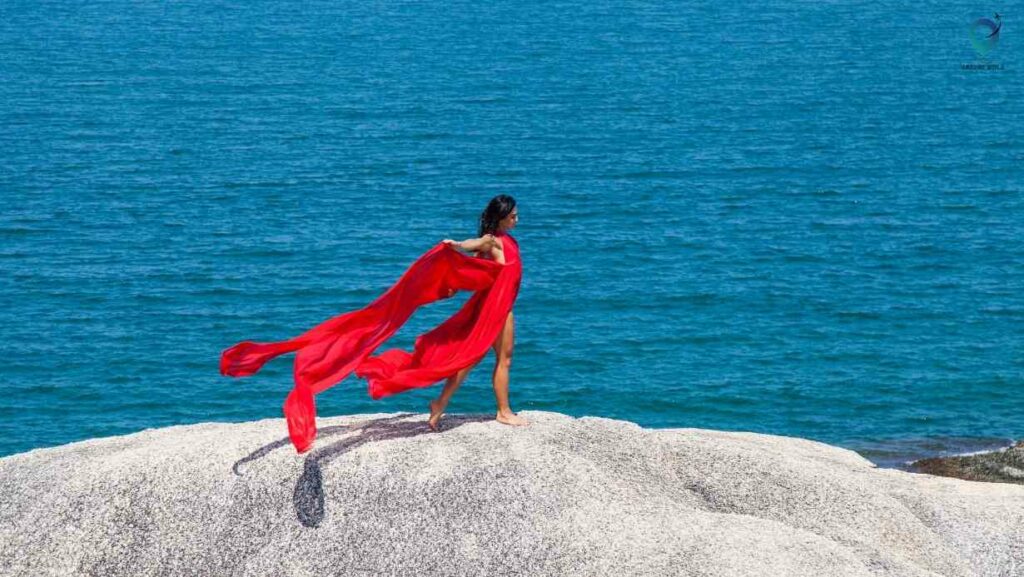
About the place: Santorini is a picturesque Greek island located in the southern Aegean Sea. Known for its stunning sunsets, whitewashed buildings with blue-domed churches, and dramatic cliffs overlooking the caldera, Santorini is a popular destination for travelers seeking romance, relaxation, and natural beauty. The island’s volcanic history has shaped its unique landscape, offering visitors not only breathtaking views but also opportunities for wine tasting, exploring archaeological sites like Akrotiri, and relaxing on beautiful beaches with black, red, or white sands. 🌅
Place Address: Santorini, Greece
How to get there:
- By Air: Fly into Santorini International Airport (JTR) from major European cities. From the airport, take a taxi or shuttle to your accommodation.
- By Sea: Take a ferry from Athens’ ports (Piraeus or Rafina) or other Greek islands like Mykonos or Crete. Ferries arrive at Athinios Port; from there, use local buses, taxis, or rental cars to reach your destination on the island.
Why to visit: Visiting Santorini allows you to experience the charm of a Greek island known for its stunning architecture, vibrant sunsets, and unique geological features. Whether wandering through the narrow streets of Oia, enjoying fresh seafood by the waterfront, or relaxing on the beaches of Kamari or Perissa, Santorini offers a blend of cultural richness and natural beauty that captivates visitors from around the world. 🏝️
Daily Average Budget:
- Accommodation: Budget around EUR 80-150 per night for mid-range hotels or traditional cave houses.
- Dining: Budget around EUR 20-40 per person for meals at local tavernas or restaurants.
- Transportation: Use local buses (around EUR 2 per ride) or rental cars (around EUR 40-60 per day) to explore the island.
- Activities: Budget for optional activities like boat tours to volcanic islands (around EUR 50-70 per person) or wine tasting tours (around EUR 30-50 per person).
Activities and Attractions:
- Watch the famous sunset from Oia or Fira with panoramic views of the caldera.
- Explore the ancient ruins of Akrotiri, a Minoan Bronze Age settlement preserved in volcanic ash.
- Relax on the beaches of Kamari, Perissa, or Red Beach, known for their unique volcanic sands.
- Visit traditional wineries in Pyrgos or Megalochori for wine tasting tours with views of the Aegean Sea.
- Discover local cuisine with dishes like moussaka, souvlaki, or fresh seafood at waterfront tavernas.
Things to Avoid:
- Overcrowded tourist areas during peak seasons; visit early in the morning or late in the afternoon for a more relaxed experience.
- Ignoring safety guidelines when exploring volcanic areas or hiking trails; wear suitable footwear and stay on designated paths.
- Engaging with unauthorized tour guides or taxi drivers; use licensed operators for tours and transportation services.
- Wasting water or energy in accommodations; conserve resources as Santorini’s water supply is limited.
11. Grand Canyon – Vast canyon carved by the Colorado River
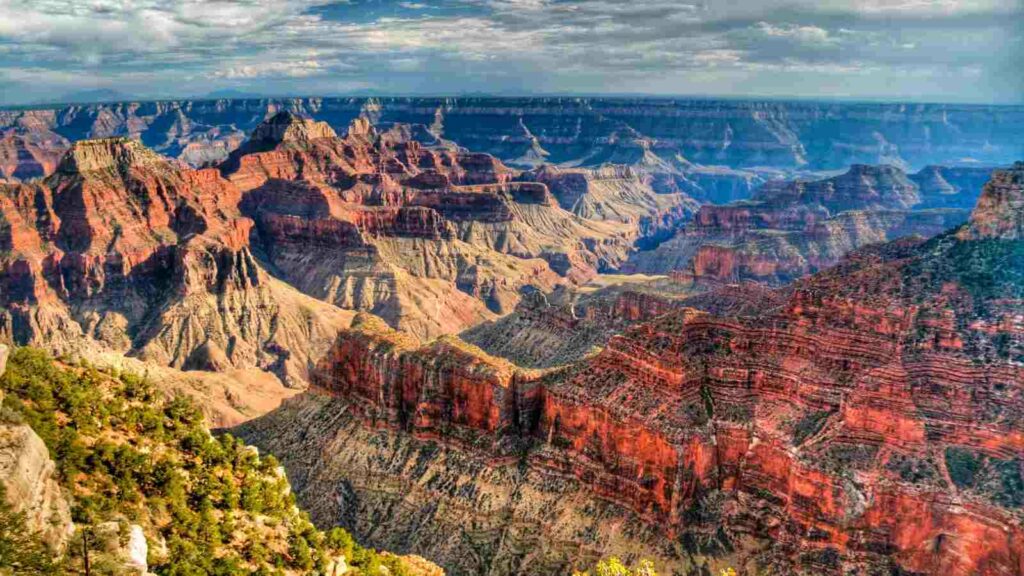
About the place: The Grand Canyon is a vast canyon carved by the Colorado River in northern Arizona, USA. Spanning approximately 277 miles (446 km) long, up to 18 miles (29 km) wide, and reaching depths of over a mile (1.6 km), the Grand Canyon is one of the world’s most impressive natural wonders. Its layered bands of red rock reveal millions of years of geological history, offering breathtaking vistas and unparalleled opportunities for hiking, rafting, and experiencing the beauty of the American Southwest. 🏞️
Place Address: Grand Canyon National Park, Arizona, USA
How to get there:
- By Air: Fly into Phoenix Sky Harbor International Airport (PHX) or Las Vegas McCarran International Airport (LAS). From there, rent a car or take a shuttle service to the Grand Canyon.
- By Car: Drive from nearby cities like Flagstaff (approximately 1.5 hours), Phoenix (approximately 3.5 hours), or Las Vegas (approximately 4.5 hours) via major highways and scenic routes.
- By Train/Bus: Amtrak offers services to Flagstaff, followed by shuttle or rental car to the Grand Canyon. Bus services also operate from major cities to nearby towns like Williams, AZ.
Why to visit: Visiting the Grand Canyon provides an awe-inspiring encounter with nature’s grandeur and geological history. Whether hiking along the South Rim trails, taking a scenic helicopter flight over the canyon, or rafting through the Colorado River rapids, the Grand Canyon offers outdoor enthusiasts and nature lovers an unforgettable experience amidst its vast landscapes and stunning vistas. 🚁
Daily Average Budget:
- National Park Entry Fee: Around USD 35 per vehicle (valid for 7 days) or USD 20 per person (pedestrians, cyclists, motorcyclists).
- Accommodation: Budget around USD 150-250 per night for lodges or hotels near the South Rim.
- Dining: Budget around USD 15-30 per person for meals at park restaurants or cafes.
- Activities: Budget for optional activities like helicopter tours (around USD 250-400 per person) or guided hikes (around USD 50-100 per person).
Activities and Attractions:
- Hike along the Rim Trail or venture into the canyon on trails like Bright Angel or South Kaibab.
- Watch sunrise or sunset over the canyon from popular viewpoints like Mather Point or Yavapai Observation Station.
- Experience the Grand Canyon Skywalk at Grand Canyon West for panoramic views from a glass-bottomed platform.
- Raft the Colorado River through the canyon on guided tours ranging from half-day to multi-day excursions.
- Visit the Grand Canyon Village for visitor centers, museums, and historic buildings like the El Tovar Hotel.
Things to Avoid:
- Venturing off designated trails without proper gear or preparation; follow park guidelines and safety recommendations.
- Overlooking hydration and sun protection; carry sufficient water and wear sunscreen when exploring the canyon.
- Feeding wildlife or leaving food unattended; maintain a respectful distance from wildlife and secure food in designated areas.
- Littering or leaving waste behind; practice Leave No Trace principles to preserve the Grand Canyon’s natural beauty.
12. Petra – Ancient archaeological site in Jordan

About the place: Petra is an ancient archaeological site located in southern Jordan, famous for its rock-cut architecture and water conduit system. Established possibly as early as 312 BC, Petra served as the capital of the Nabataean Kingdom and later became a major trading hub along ancient caravan routes. Carved into sandstone cliffs, its most famous structure is the Treasury (Al-Khazneh), adorned with intricate facades and believed to have been a royal tomb.
The site’s significance lies in its blend of Hellenistic, Eastern, and Roman architectural influences, offering visitors a glimpse into ancient civilizations amidst stunning desert landscapes. 🏛️
Place Address: Petra Archaeological Park, Petra, Jordan
How to get there:
- By Air: Fly into Queen Alia International Airport (AMM) in Amman, Jordan. From Amman, take a 3-hour drive south to Petra via the Desert Highway, or arrange for a private transfer or tour.
- By Road: Drive from nearby cities like Aqaba (approximately 2 hours) or Wadi Rum (approximately 1.5 hours) via well-marked highways and scenic routes.
- By Bus: Public buses operate from Amman to Petra; alternatively, join organized tours or hire local taxis from nearby towns like Wadi Musa.
Why to visit: Visiting Petra offers a journey into ancient history and architectural marvels set amidst rugged desert landscapes. Whether exploring the narrow Siq canyon leading to the Treasury, climbing to the Monastery (Ad Deir) with its panoramic views, or discovering lesser-known tombs and temples, Petra captivates with its rich cultural heritage and archaeological significance. 🏜️
Daily Average Budget:
- Entrance Fee: Around JOD 50-90 (Jordanian Dinar) per person for a one-day ticket to Petra Archaeological Park.
- Accommodation: Budget around JOD 50-100 per night for hotels or guesthouses in nearby Wadi Musa.
- Dining: Budget around JOD 10-20 per person for meals at local restaurants or cafes.
- Activities: Budget for optional activities like guided tours (around JOD 50-100 per person) or horseback rides through Petra’s ancient paths.
Activities and Attractions:
- Explore the Treasury (Al-Khazneh), Petra’s most iconic monument, carved into the sandstone cliff face.
- Walk through the Siq, a narrow canyon leading to Petra’s main sites, featuring natural rock formations and ancient water channels.
- Visit the Royal Tombs, including the Urn Tomb and the Palace Tomb, showcasing elaborate facades and burial chambers.
- Climb to the Monastery (Ad Deir), a larger and less crowded structure atop a hill offering panoramic views of Petra and the surrounding desert.
- Discover Petra’s lesser-known sites like the High Place of Sacrifice, the Great Temple, and the Byzantine Church.
Things to Avoid:
- Hiking without proper footwear or equipment; wear sturdy shoes and carry sufficient water when exploring Petra’s rocky terrain.
- Engaging with unauthorized guides or vendors; use licensed tour operators or official guides for informative and safe visits.
- Touching or climbing on ancient structures; respect preservation efforts and signage to maintain Petra’s architectural integrity.
- Littering or leaving waste behind; use designated bins and practice responsible tourism to preserve Petra’s natural and cultural heritage.
13. Serengeti National Park – Famous wildlife reserve in Tanzania
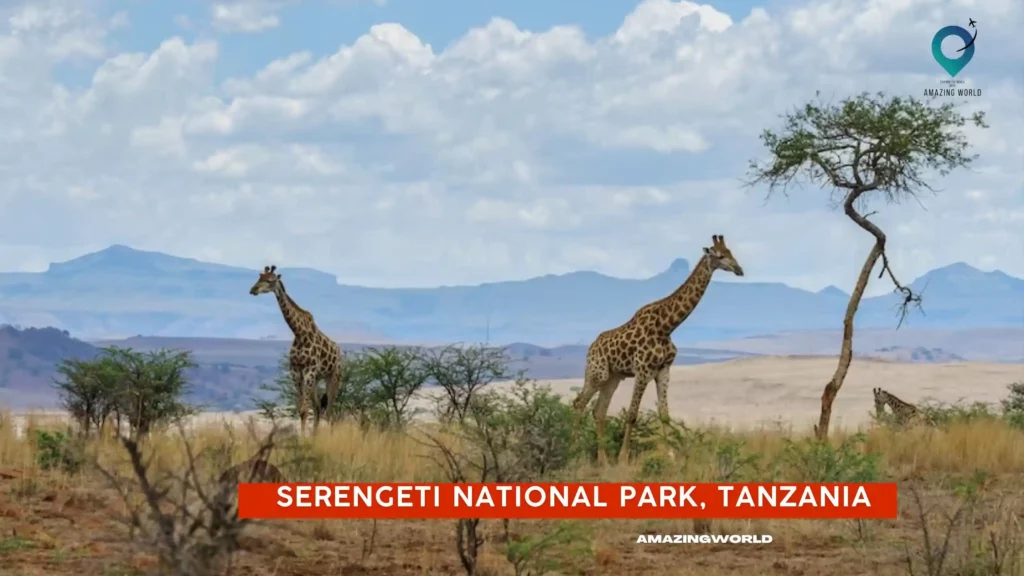
About the place: Serengeti National Park is a world-renowned wildlife reserve located in northern Tanzania, known for its vast savannahs, diverse ecosystems, and annual wildebeest migration. Spanning approximately 14,750 square kilometers, the Serengeti is home to an incredible array of wildlife, including the “Big Five” (lion, leopard, elephant, buffalo, and rhinoceros), cheetahs, giraffes, and hundreds of bird species. The park’s landscapes range from open grasslands to acacia woodlands and riverine forests, offering unparalleled opportunities for safari adventures and wildlife photography amidst Tanzania’s natural beauty. 🦁
Place Address: Serengeti National Park, Tanzania
How to get there:
- By Air: Fly into Kilimanjaro International Airport (JRO) near Arusha, Tanzania. From Arusha, take a connecting flight to Seronera Airstrip or other airstrips within the Serengeti National Park.
- By Road: Drive from Arusha (approximately 6-8 hours) via the Ngorongoro Conservation Area and Serengeti’s main entrance gates (Seronera, Naabi Hill, or Klein’s Gate). Use 4×4 vehicles for safari drives on unpaved roads.
- By Safari Tour: Join organized safari tours departing from Arusha or other major Tanzanian cities, including accommodation, meals, and guided game drives within Serengeti National Park.
Why to visit: Visiting Serengeti National Park promises an unforgettable wildlife safari experience in one of Africa’s most iconic conservation areas. Whether witnessing the Great Migration of wildebeest and zebras across the plains, tracking predators on game drives, or encountering large herds of elephants at watering holes, the Serengeti offers nature enthusiasts and wildlife lovers a chance to connect with Tanzania’s abundant biodiversity and natural wonders. 🐘
Daily Average Budget:
- Park Entry Fee: Around USD 60-70 per person per day for non-East African residents, including vehicle fees for safari drives.
- Accommodation: Budget around USD 150-300 per night for tented camps or lodges within or near Serengeti National Park.
- Dining: Budget around USD 20-40 per person for meals at safari lodges, camps, or picnic sites within the park.
- Activities: Budget for optional activities like hot air balloon safaris (around USD 500-600 per person) or walking safaris with experienced guides.
Activities and Attractions:
- Witness the Great Migration (July to October) of over a million wildebeest and zebras crossing the Mara River in search of fresh grazing grounds.
- Embark on morning and evening game drives to spot lions, leopards, cheetahs, and other predators hunting or resting in the Serengeti’s varied habitats.
- Visit the Moru Kopjes, granite rock formations favored by lions and elephants, offering scenic viewpoints and ancient Maasai rock paintings.
- Explore the Seronera River Valley for year-round wildlife sightings, including hippos, crocodiles, and diverse birdlife.
- Experience traditional Maasai culture with community visits or cultural performances near Serengeti National Park.
Things to Avoid:
- Approaching wildlife too closely or attempting to feed animals; respect park regulations and maintain a safe distance during wildlife encounters.
- Leaving vehicles or designated safari areas without a guide or ranger; follow instructions for guided walks or nature trails led by experienced professionals.
- Littering or leaving plastic waste behind; dispose of trash responsibly and use eco-friendly practices to protect Serengeti’s fragile ecosystems.
- Disrupting natural behaviors or habitats; minimizing noise and respect wildlife viewing etiquette to ensure a respectful and sustainable safari experience in Serengeti National Park.
14. Venice – Romantic canal-filled city in Italy

About the place: Venice, often referred to as the “City of Canals,” is a romantic and picturesque city located in northeastern Italy. Built on more than 100 small islands in the Adriatic Sea, Venice is renowned for its intricate network of canals, historic architecture, and artistic heritage. The city’s Grand Canal serves as its main thoroughfare, lined with elegant Renaissance and Gothic palaces that once belonged to wealthy merchants and nobles.
Venice is also famous for its vibrant culture, including annual events like the Venice Carnival and the Venice Biennale, attracting visitors from around the world to explore its unique charm and timeless beauty. 🚤
Place Address: Venice, Italy
How to get there:
- By Air: Fly into Venice Marco Polo Airport (VCE) or Treviso Airport (TSF), both serving international and domestic flights. From the airport, take a water taxi or bus to Venice’s historic center.
- By Train: Arrive at Venezia Santa Lucia railway station, located near the Grand Canal in Venice. Trains connect Venice with major Italian cities like Milan, Florence, and Rome.
- By Water: Travel by vaporetto (water bus) along Venice’s canals, with routes connecting popular landmarks and neighborhoods throughout the city. Gondolas offer a traditional and scenic way to explore Venice’s smaller canals and picturesque bridges.
Why to visit: Visiting Venice offers a unique opportunity to experience a city built on water, where every corner reveals architectural marvels, hidden courtyards, and centuries-old history. Whether taking a romantic gondola ride along the narrow canals, visiting iconic landmarks like St. Mark’s Basilica and the Doge’s Palace, or indulging in Venetian cuisine at local trattorias, Venice captivates with its blend of art, culture, and unparalleled Venetian lifestyle. 🍷
Daily Average Budget:
- Accommodation: Budget around EUR 100-200 per night for hotels or guesthouses in Venice’s historic districts like San Marco or Cannaregio.
- Dining: Budget around EUR 20-40 per person for meals at trattorias or osterias serving traditional Venetian dishes like seafood risotto, cicchetti (small plates), and gelato.
- Activities: Budget for optional activities such as museum visits (around EUR 10-20 per person), gondola rides (around EUR 80-100 per ride), or guided tours of Venice’s art and architecture.
Activities and Attractions:
- Explore St. Mark’s Square (Piazza San Marco) and its iconic landmarks, including St. Mark’s Basilica, the Campanile (bell tower), and the Doge’s Palace.
- Wander through Venice’s historic neighborhoods, such as Dorsoduro with its art galleries and the Jewish Ghetto with its cultural heritage.
- Visit the Rialto Bridge (Ponte di Rialto), spanning the Grand Canal and hosting a bustling market with local produce and souvenirs.
- Discover Venice’s art scene at the Peggy Guggenheim Collection and the Accademia Galleries, showcasing works by Venetian masters and modern artists.
- Attend cultural events like the Venice Carnival (Carnevale di Venezia) or the Venice Biennale, celebrating art, music, and theater against the backdrop of Venetian landmarks.
Things to Avoid:
- Overpaying for gondola rides; negotiate prices in advance and confirm the duration and route to avoid misunderstandings.
- Eating at tourist traps in St. Mark’s Square; explore quieter streets for authentic Venetian dining experiences.
- Feeding pigeons in public areas; respect local regulations and maintain cleanliness in Venice’s historic sites and squares.
- Visiting during peak tourist seasons without booking accommodations and activities in advance; plan visits during quieter months for a more relaxed experience in Venice. 🌅
15. Kyoto – A historic city with temples and gardens in Japan

About the place: Kyoto, located in the Kansai region of Japan, is a historic city renowned for its cultural heritage, traditional architecture, and serene gardens. Once the imperial capital of Japan for over a thousand years, Kyoto preserves its rich history through UNESCO World Heritage sites, including ancient temples, Shinto shrines, and well-preserved wooden machiya townhouses. The city’s atmospheric streets, lined with cherry blossom trees in spring and vibrant foliage in autumn, offer visitors a glimpse into Japan’s past and its enduring traditions, from tea ceremonies and kaiseki cuisine to seasonal festivals and geisha performances. 🏯
Place Address: Kyoto, Japan
How to get there:
- By Air: Fly into Kansai International Airport (KIX) near Osaka, Japan’s main international gateway. From Kansai Airport, take a direct train (Haruka Express) to Kyoto Station (approximately 75-90 minutes).
- By Train: Arrive at Kyoto Station, a major transportation hub with Shinkansen (bullet train) connections from Tokyo, Osaka, and other Japanese cities. Local trains and buses provide access to Kyoto’s historic districts and attractions.
- By Bus: Travel by highway bus from neighboring cities like Osaka (approximately 1 hour) or Tokyo (approximately 8-9 hours), with convenient schedules and direct routes to Kyoto’s downtown area.
Why to visit: Visiting Kyoto offers a journey through Japan’s cultural heart, where ancient traditions coexist with modern innovations. Whether exploring iconic landmarks like Kinkaku-ji (Golden Pavilion) and Fushimi Inari Taisha Shrine, participating in a tea ceremony in a traditional machiya house, or strolling through historic districts like Gion with its preserved wooden buildings and geisha culture, Kyoto captivates with its timeless elegance and reverence for Japanese heritage. 🍵
Daily Average Budget:
- Accommodation: Budget around JPY 10,000-20,000 per night for ryokan (traditional inns) or hotels in Kyoto’s central districts like Gion or Higashiyama.
- Dining: Budget around JPY 1,500-3,000 per person for meals at local restaurants serving Kyoto cuisine, including kaiseki (multi-course meals) and seasonal specialties.
- Activities: Budget for optional activities such as guided tours (around JPY 1,000-3,000 per person), kimono rentals, or visits to cultural workshops for calligraphy or pottery.
Activities and Attractions:
- Visit Kinkaku-ji (Golden Pavilion), a Zen Buddhist temple with its iconic golden pavilion reflecting in the surrounding pond.
- Explore Fushimi Inari Taisha Shrine, known for its thousands of vermillion torii gates leading up to Mount Inari, offering panoramic views of Kyoto.
- Wander through Arashiyama Bamboo Grove and nearby Tenryu-ji Temple, known for its historic garden and serene atmosphere.
- Experience a traditional tea ceremony at venues like Camellia Tea Ceremony in Gion or En Tea Ceremony in Higashiyama.
- Attend seasonal festivals like Hanami (cherry blossom viewing) in spring or Gion Matsuri (Kyoto’s famous festival) in summer, featuring parades and traditional performances.
Things to Avoid:
- Disrupting ceremonies or rituals at temples and shrines; observe respectful behavior and photography guidelines when visiting sacred sites in Kyoto.
- Overpacking itineraries; prioritize quality over quantity when exploring Kyoto’s historic sites and cultural experiences.
- Visiting popular attractions during peak hours; plan visits early in the morning or late afternoon to avoid crowds and enjoy a more serene atmosphere.
- Missing out on local delicacies like yuba (tofu skin), yudofu (hot tofu), and wagashi (traditional sweets); savor Kyoto’s culinary traditions at local restaurants and tea houses.
16. Yellowstone National Park – Oldest national park in the world

About the place: Yellowstone National Park, established in 1872, is not only America’s first but also the world’s oldest national park. Located primarily in Wyoming, with parts extending into Montana and Idaho, Yellowstone is renowned for its geothermal features, wildlife, and expansive landscapes.
The park sits atop a volcanic hotspot, resulting in geysers, hot springs, and bubbling mud pots that are iconic symbols of its natural wonders. Yellowstone’s diverse ecosystems support a wide array of wildlife, including grizzly bears, wolves, and herds of bison and elk, making it a haven for nature enthusiasts and photographers alike. 🌲
Place Address: Yellowstone National Park, Wyoming, USA
How to get there:
- By Air: Fly into Yellowstone Airport (WYS) near West Yellowstone, Montana, or Jackson Hole Airport (JAC) in Wyoming. From the airport, rent a car or take a shuttle to reach different entrances of Yellowstone National Park.
- By Car: Access the park via major highways such as US-89 from the north (Montana), US-191 from the west (Idaho), or US-20 from the south (Wyoming). Follow signs to designated park entrances, each offering access to different regions of Yellowstone.
Why to visit: Visiting Yellowstone offers an unparalleled opportunity to witness natural wonders and explore pristine wilderness. From iconic geothermal areas like Old Faithful and Grand Prismatic Spring to the stunning Yellowstone Lake and dramatic canyons, the park captivates with its rugged beauty and unique geological features. Whether hiking along scenic trails, observing wildlife in their natural habitats, or camping under starry skies, Yellowstone promises an unforgettable outdoor adventure in the heart of the American West. 🌌
Daily Average Budget:
- Accommodation: Budget around USD 100-300 per night for lodges, cabins, or campgrounds within Yellowstone National Park or nearby gateway towns like West Yellowstone or Gardiner.
- Dining: Budget around USD 20-50 per person for meals at park restaurants, cafes, or bring picnic supplies for outdoor dining amidst Yellowstone’s natural beauty.
Activities and Attractions:
- Watch Old Faithful erupt on schedule, showcasing one of the world’s most famous geysers with its impressive steam and water displays.
- Explore the Grand Canyon of the Yellowstone, featuring the Lower Falls and hiking trails offering panoramic views of the canyon’s rugged cliffs and rushing waters.
- Spot wildlife such as bison, elk, bears, and wolves in Lamar Valley and Hayden Valley, renowned for their diverse habitats and natural wildlife sightings.
- Visit Mammoth Hot Springs, a terraced landscape of travertine formations created by hot springs, offering boardwalk trails and scenic overlooks.
- Enjoy outdoor activities such as hiking, fishing, wildlife watching, and photography across Yellowstone’s diverse ecosystems and natural landmarks.
Things to Avoid:
- Approaching or feeding wildlife; maintain a safe distance and observe park regulations to protect both animals and visitors.
- Straying off designated trails or boardwalks in thermal areas; follow marked paths and safety guidelines to avoid accidents and protect delicate geothermal features.
- Underestimating travel times between park attractions; plan for traffic, wildlife crossings, and seasonal road closures when exploring Yellowstone’s expansive landscapes.
- Missing out on ranger-led programs and educational exhibits; enhance your park experience with insights into Yellowstone’s natural history, conservation efforts, and ongoing research initiatives.
17. Angkor Wat – Largest religious monument in the world

About the place: Angkor Wat, located in Cambodia’s Siem Reap province, is the largest religious monument in the world and a UNESCO World Heritage site. Built in the 12th century during the Khmer Empire’s peak, Angkor Wat is a masterpiece of Khmer architecture, encompassing a vast temple complex dedicated to the Hindu god Vishnu, later transformed into a Buddhist site.
Its iconic silhouette, with five soaring towers and intricate bas-reliefs depicting Hindu epics and celestial beings, reflects the empire’s grandeur and spiritual devotion. Surrounded by a moat and encompassing nearly 162.6 hectares (402 acres), Angkor Wat remains a symbol of Cambodia’s cultural heritage and architectural brilliance. 🏛️
Place Address: Angkor Archaeological Park, Siem Reap, Cambodia
How to get there:
- By Air: Fly into Siem Reap International Airport (REP), which serves domestic and international flights. From the airport, take a taxi or shuttle to Siem Reap town, where hotels and tour operators offer transportation to Angkor Archaeological Park.
- By Tuk-Tuk: Hire a tuk-tuk (motorized rickshaw) for convenient access to Angkor Wat and other temples within Angkor Archaeological Park. Tuk-tuks are a popular and affordable option for exploring Siem Reap’s historic sites.
Why to visit: Visiting Angkor Wat offers a journey through Cambodia’s ancient history and architectural splendor. Beyond its monumental scale and intricate carvings, Angkor Wat represents a spiritual and cultural legacy, with its labyrinthine corridors, galleries, and central sanctuary housing revered Buddha statues.
Whether witnessing sunrise over the temple’s iconic towers, exploring nearby temples like Bayon and Ta Prohm engulfed by jungle, or immersing in Khmer art and mythology through intricate stone carvings, Angkor Wat remains a testament to human creativity and devotion across centuries. 🌅
Daily Average Budget:
- Accommodation: Budget around USD 50-150 per night for hotels or guesthouses in Siem Reap, offering convenient access to Angkor Wat and other archaeological sites.
- Dining: Budget around USD 10-20 per person for meals at local restaurants or street food stalls serving Cambodian specialties like amok (fish curry) and Khmer noodles.
- Activities: Budget for an Angkor Archaeological Park pass (USD 37 for a one-day pass, USD 62 for a three-day pass) to explore Angkor Wat and other temples at your own pace.
Activities and Attractions:
- Explore Angkor Wat’s central complex, including its galleries, libraries, and towering central spires, adorned with elaborate bas-reliefs depicting scenes from Hindu mythology and Khmer history.
- Witness sunrise or sunset over Angkor Wat from designated viewpoints, capturing the temple’s reflection in the surrounding moat and golden hues illuminating its ancient sandstone structures.
- Visit Bayon Temple, famous for its enigmatic smiling faces carved into stone towers, symbolizing the intersection of earthly and divine realms in Khmer art and architecture.
- Discover Ta Prohm Temple, enveloped by massive tree roots and lush vegetation, offering a glimpse into Angkor’s centuries-old embrace by Cambodia’s tropical jungle.
- Attend cultural performances in Siem Reap, showcasing traditional Khmer dance, music, and storytelling, complementing your exploration of Angkor Wat’s historical and artistic legacy.
Things to Avoid:
- Climbing on fragile structures or touching ancient carvings at Angkor Wat and other temples; preserve the integrity of cultural heritage sites by respecting signage and guidelines.
- Visiting during peak tourist hours; explore Angkor Wat early in the morning or late afternoon to avoid crowds and enjoy a more tranquil experience.
- Engaging with unauthorized tour guides or purchasing souvenirs from unauthorized vendors; support local businesses and respect ethical tourism practices when visiting Siem Reap’s cultural landmarks.
- Overlooking conservation efforts and sustainable tourism practices; contribute to the preservation of Angkor Archaeological Park by disposing of waste responsibly and supporting eco-friendly initiatives during your visit. 🌿
18. Bora Bora – Stunning Island in French Polynesia
About the place: Bora Bora is a breathtaking island located in French Polynesia, renowned for its turquoise lagoon, coral reefs, and overwater bungalows. Situated northwest of Tahiti in the South Pacific, Bora Bora is surrounded by a barrier reef and a dormant volcano, Mount Otemanu, creating a picturesque backdrop for its tropical paradise.
Visitors can indulge in water activities such as snorkeling, scuba diving, and jet-skiing amidst vibrant marine life and crystal-clear waters. The island’s luxurious resorts offer unparalleled views of the lagoon and opportunities to unwind in secluded luxury, making Bora Bora a dream destination for honeymooners and travelers seeking a tranquil escape. 🏝️
Place Address: Bora Bora, French Polynesia
How to get there:
- By Air: Fly into Bora Bora Airport (BOB) from Tahiti’s Faa’a International Airport (PPT) via Air Tahiti or other domestic airlines. From Bora Bora Airport, transfer to your resort via boat shuttle or private water taxi, which offer scenic views of the lagoon and Mount Otemanu.
- By Sea: Arrive by cruise ship to Bora Bora’s port, where tender boats transport passengers to the island. Many cruises include Bora Bora as a highlight of their South Pacific itineraries, providing opportunities to explore the island’s natural beauty and cultural attractions.
Why to visit: Visiting Bora Bora promises a once-in-a-lifetime experience surrounded by natural beauty and luxurious amenities. Whether relaxing in an overwater bungalow with direct access to the lagoon, enjoying spa treatments inspired by Polynesian traditions, or embarking on a sunset cruise showcasing the island’s breathtaking scenery, Bora Bora offers unparalleled opportunities for relaxation and romance. Adventurous travelers can explore the island’s hiking trails, ancient temples, and local markets, immersing in French Polynesia’s rich culture and warm hospitality amid a backdrop of paradise. 🌅
Daily Average Budget:
- Accommodation: Budget around USD 500-1500 per night for overwater bungalows or beachfront villas at luxury resorts in Bora Bora, offering exclusive amenities and panoramic views of the lagoon.
- Dining: Budget around USD 50-150 per person for dining at resort restaurants or local eateries, featuring fresh seafood, tropical fruits, and Polynesian-inspired cuisine.
Activities and Attractions:
- Snorkel or dive in Bora Bora’s lagoon, home to vibrant coral gardens, tropical fish, and marine species like rays and sharks, offering unforgettable underwater encounters.
- Take a boat tour or paddleboard across the lagoon’s turquoise waters, exploring secluded motus (small islets) and scenic viewpoints overlooking Mount Otemanu.
- Visit Matira Beach, renowned for its powdery white sand and calm waters ideal for swimming, sunbathing, and enjoying panoramic sunsets over the Pacific Ocean.
- Experience Polynesian culture through traditional dance performances, handicraft demonstrations, and visits to local villages, offering insights into Bora Bora’s indigenous heritage and customs.
- Relax with spa treatments featuring local ingredients such as monoi oil, vanilla, and tiare flowers, enhancing wellness and relaxation amidst Bora Bora’s serene natural surroundings.
Things to Avoid:
- Feeding or touching marine wildlife in Bora Bora’s lagoon; respect marine conservation efforts and avoid disturbing the island’s delicate ecosystem.
- Overpacking for your trip; pack light and include essentials such as sunscreen, swimwear, and casual resort attire suitable for Bora Bora’s tropical climate.
- Ignoring local customs and traditions; embrace Polynesian hospitality by learning basic Tahitian phrases, observing cultural etiquette, and supporting sustainable tourism practices during your stay.
- Missing out on exploring Bora Bora’s diverse landscapes and attractions; plan excursions and activities to maximize your time on the island and create lasting memories of your South Pacific adventure. 🌴
19. Dubai – Modern city known for luxury shopping and futuristic architecture
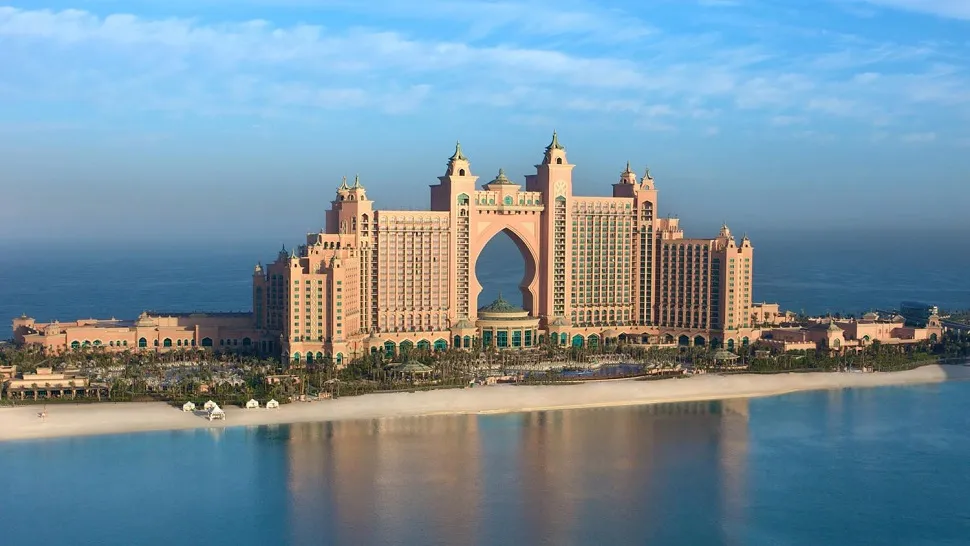
About the place: Dubai is a dynamic city in the United Arab Emirates (UAE), renowned for its futuristic skyline, luxury shopping, and ambitious architectural projects. Situated on the southeast coast of the Arabian Peninsula, Dubai blends traditional Emirati culture with modern innovation, offering visitors a glimpse into the Middle East’s vibrant cosmopolitan lifestyle.
The city is famous for landmarks like the Burj Khalifa, the world’s tallest building, and the Palm Jumeirah, a man-made archipelago featuring luxury resorts and exclusive residences. Dubai’s bustling souks, desert safaris, and cultural attractions showcase its rich heritage, while shopping malls, fine dining restaurants, and entertainment venues cater to diverse tastes and preferences. 🏙️
Place Address: Dubai, United Arab Emirates
How to get there:
- By Air: Fly into Dubai International Airport (DXB), one of the world’s busiest airports, offering direct flights from major cities worldwide. From the airport, take a taxi, metro, or private transfer to your hotel or accommodation in Dubai’s city center or surrounding districts.
- By Land: Drive into Dubai from neighboring Emirates via well-maintained highways and border crossings, or travel by bus/coach from cities like Abu Dhabi, Sharjah, or Al Ain, connecting to Dubai’s public transport network.
Why to visit: Visiting Dubai promises an unforgettable experience blending luxury, innovation, and cultural diversity. Whether ascending to the observation deck of the Burj Khalifa for panoramic city views, shopping at world-class malls like The Dubai Mall and Mall of the Emirates, or exploring traditional souks for gold, spices, and textiles, Dubai offers a myriad of experiences for every traveler. From camel riding in desert dunes and experiencing Bedouin hospitality in desert camps to enjoying water sports along Dubai’s coastline and attending cultural festivals and events, the city captivates with its blend of ancient traditions and contemporary allure. 🌟
Daily Average Budget:
- Accommodation: Budget around USD 100-300 per night for hotels or serviced apartments in Dubai, offering amenities such as pool access, gym facilities, and convenient access to shopping and dining venues.
- Dining: Budget around USD 20-50 per person for meals at local cafes, street food stalls, or upscale restaurants serving international cuisine and Emirati specialties like shawarma, mezze, and Arabic coffee.
Activities and Attractions:
- Visit the Burj Khalifa, Dubai’s iconic skyscraper, and ascend to the observation deck for panoramic views of the city skyline, coastline, and desert landscapes stretching across the UAE.
- Explore The Dubai Mall, one of the world’s largest shopping and entertainment destinations, featuring luxury boutiques, indoor theme parks like Dubai Aquarium & Underwater Zoo, and the Dubai Fountain’s mesmerizing water and light show.
- Discover Dubai’s cultural heritage at Al Fahidi Historical Neighborhood, home to restored wind-tower houses, art galleries, and Dubai Museum, offering insights into the city’s evolution from a fishing village to a global metropolis.
- Experience traditional Emirati hospitality at Dubai’s souks (markets), including the Gold Souk, Spice Souk, and Textile Souk, where you can bargain for jewelry, spices, fabrics, and handicrafts amid bustling alleyways and vibrant bazaars.
- Relax on Jumeirah Beach or explore Dubai’s man-made islands and waterfront developments like Palm Jumeirah, featuring luxury resorts, beach clubs, and water sports activities overlooking the Arabian Gulf.
Things to Avoid:
- Public displays of affection or attire considered inappropriate in Islamic culture; respect local customs and dress codes, especially when visiting religious sites or interacting with local residents.
- Engaging in unauthorized activities or consuming alcohol outside designated areas; adhere to UAE laws and regulations regarding alcohol consumption, public behavior, and cultural sensitivities during your stay in Dubai.
- Overlooking safety precautions in desert activities or water sports; choose licensed tour operators and follow safety guidelines for desert safaris, dune bashing, camel riding, and water-based activities to ensure a safe and enjoyable experience.
- Neglecting to plan for Dubai’s climate and weather conditions; pack lightweight clothing suitable for hot desert temperatures, and stay hydrated while exploring outdoor attractions and participating in recreational activities across the city. 🌞
20. Maldives – Tropical paradise known for its luxury resorts

About the place: The Maldives is a tropical archipelago in the Indian Ocean, known for its pristine white-sand beaches, turquoise waters, and luxurious overwater bungalows. Comprising 26 atolls and over 1,000 coral islands, the Maldives offers unparalleled opportunities for snorkeling, diving, and beachfront relaxation amidst coral reefs teeming with marine life.
Each island resort is a secluded retreat, featuring private villas with direct access to the lagoon, spa treatments incorporating local ingredients, and gourmet dining experiences overlooking the ocean. Whether indulging in water sports, exploring vibrant coral gardens, or simply unwinding on secluded beaches, the Maldives epitomizes tropical paradise and luxury escapism. 🏝️
Place Address: Maldives, Indian Ocean
How to get there:
- By Air: Fly into Velana International Airport (MLE), the main gateway to the Maldives, from major cities worldwide. From the airport, take a seaplane transfer or domestic flight to your resort island, offering scenic aerial views of atolls and turquoise lagoons.
- By Sea: Arrive by cruise ship or yacht charter to Male, the capital city, where transfers to resort islands are available via speedboat or traditional dhoni (wooden boat), providing opportunities to explore local culture and coastal landscapes.
Why to visit: Visiting the Maldives promises a luxurious retreat surrounded by natural beauty and unparalleled hospitality. Whether snorkeling alongside manta rays and whale sharks, enjoying sunset cruises aboard a traditional dhoni, or stargazing on secluded beaches, the Maldives offers exclusive experiences for honeymooners and travelers seeking romance and relaxation.
Indulge in holistic spa treatments, beachfront yoga sessions, or underwater dining experiences showcasing the Maldives’ marine biodiversity and culinary delights, creating lasting memories of tropical indulgence and serenity. 🌅
Daily Average Budget:
- Accommodation: Budget around USD 500-2000 per night for overwater villas or beachfront suites at luxury resorts in the Maldives, offering exclusive amenities such as private pools, butler service, and panoramic ocean views.
- Dining: Budget around USD 50-150 per person for dining at resort restaurants or local eateries, featuring fresh seafood, international cuisine, and romantic beachfront settings overlooking the Indian Ocean.
- Activities: Budget for optional activities such as snorkeling excursions (around USD 100-300 per person), sunset cruises, spa treatments, and cultural experiences highlighting Maldivian traditions and hospitality.
Activities and Attractions:
- Snorkel or dive in the Maldives’ coral gardens and marine protected areas, home to colorful fish, sea turtles, and coral formations showcasing the Indian Ocean’s biodiversity and underwater landscapes.
- Explore local islands and Male’s cultural landmarks, including the Old Friday Mosque, National Museum, and vibrant markets offering handicrafts, souvenirs, and traditional Maldivian cuisine.
- Embark on dolphin-watching cruises, fishing trips, or seaplane flights over atolls and islands, providing aerial views of the Maldives’ turquoise lagoons, sandbanks, and uninhabited islets.
- Relax on pristine beaches, participate in water sports activities such as kayaking, paddleboarding, and jet skiing, or enjoy sunset yoga sessions and beachside dining experiences highlighting Maldivian flavors and culinary traditions.
Things to Avoid:
- Disturbing coral reefs or marine wildlife during snorkeling and diving activities; practice responsible tourism and adhere to guidelines for marine conservation and protection of fragile ecosystems.
- Overpacking for your trip; pack light and include essentials such as sunscreen, swimwear, and casual resort attire suitable for the Maldives’ tropical climate and beachfront activities.
- Ignoring local customs and traditions; respect Islamic practices, dress modestly in public areas, and observe cultural etiquette when interacting with local residents or visiting religious sites across the Maldives.
- Missing out on exploring different atolls and island resorts; plan excursions and island-hopping tours to experience diverse landscapes, activities, and hospitality options available throughout the Maldives’ archipelago. 🌴
21. Amazon Rainforest – Largest tropical rainforest in the world
About the place: The Amazon Rainforest is the largest tropical rainforest in the world, spanning nine countries in South America and covering over 5.5 million square kilometers of dense vegetation, rivers, and diverse ecosystems. Known as the “Lungs of the Earth,” the Amazon plays a crucial role in global climate regulation, biodiversity conservation, and indigenous cultures, housing millions of plant and animal species found nowhere else on Earth.
From towering canopy trees and winding rivers to vibrant bird species and elusive jaguars, the Amazon Rainforest offers unparalleled opportunities for eco-tourism, scientific research, and cultural immersion amidst its rich natural heritage and environmental significance. 🌳
Place Address: Amazon Rainforest, South America
How to get there:
- By Air: Fly into major cities such as Manaus (Brazil), Iquitos (Peru), or Leticia (Colombia) with connecting flights from international airports worldwide. From regional hubs, take domestic flights or riverboat cruises to remote lodges and eco-resorts within the Amazon Rainforest.
- By River: Access the Amazon Rainforest via riverboat cruises departing from port cities like Manaus or Iquitos, offering multi-day excursions along the Amazon River and its tributaries, showcasing diverse wildlife, indigenous communities, and scenic landscapes.
Why to visit: Visiting the Amazon Rainforest offers a transformative journey into one of the world’s most biodiverse and culturally rich environments. Whether exploring pristine jungle trails, encountering wildlife species such as monkeys, sloths, and pink river dolphins, or meeting indigenous tribes preserving ancestral traditions, the Amazon provides immersive experiences in eco-tourism and sustainable travel. Participate in guided hikes, birdwatching tours, and nocturnal safaris led by local guides, learning about medicinal plants, indigenous folklore, and conservation efforts aimed at protecting the rainforest’s fragile ecosystems and endemic species. 🦜
Daily Average Budget:
- Accommodation: Budget around USD 100-500 per night for eco-lodges, jungle camps, or riverboat cabins in the Amazon Rainforest, offering rustic charm, all-inclusive packages, and immersive nature experiences amid pristine wilderness.
- Dining: Budget around USD 20-50 per person for meals at lodge restaurants or riverboat dining, featuring regional cuisine, fresh seafood, and tropical fruits sourced from local communities and sustainable practices.
Activities and Attractions:
- Explore canopy walkways and observation towers for birdwatching and panoramic views of the Amazon Rainforest’s diverse landscapes, canopy layers, and wildlife habitats.
- Visit local communities and indigenous villages along the Amazon River, learning about traditional crafts, rituals, and sustainable practices preserving ancestral knowledge and cultural heritage.
- Navigate tributaries and oxbow lakes by kayak or motorized canoe, encountering rare species like giant otters, anacondas, and exotic birdlife amidst the rainforest’s waterways and flooded forests.
- Participate in eco-friendly activities such as tree planting, wildlife monitoring, and environmental education programs, contributing to conservation efforts and sustainable development initiatives across the Amazon basin.
- Relax in natural thermal springs, explore caves, and embark on photographic safaris capturing the Amazon’s natural beauty, diverse ecosystems, and remote wilderness areas protected as UNESCO World Heritage Sites.
Things to Avoid:
- Engaging in unauthorized fishing, hunting, or wildlife trafficking; respect wildlife protection laws and guidelines for responsible tourism, supporting conservation efforts and sustainable practices in the Amazon Rainforest.
- Disposing of waste improperly or disturbing sensitive habitats; practice eco-friendly travel habits, minimize plastic use, and participate in recycling programs at eco-lodges and community initiatives promoting environmental stewardship.
- Underestimating the Amazon’s climate and weather conditions; pack lightweight, moisture-wicking clothing, insect repellent, and sunscreen for protection against sun exposure, humidity, and tropical diseases prevalent in the rainforest environment.
- Overlooking safety precautions during jungle excursions and river activities; follow local guides’ instructions, use protective gear, and stay informed about potential risks associated with wildlife encounters, river navigation, and remote travel in the Amazon Rainforest. 🌿
22. Mount Everest – The tallest mountain in the world
About the place: Mount Everest, standing at 8,848 meters (29,029 feet), is the highest peak in the world, located in the Himalayas on the border between Nepal and Tibet. Known locally as “Sagarmatha” in Nepal and “Chomolungma” in Tibet, Mount Everest is a symbol of human endurance and natural wonder. Climbing Everest is a pinnacle achievement for mountaineers worldwide, presenting both physical challenges and breathtaking views of snow-capped peaks and glaciers. The base camps on both the Nepalese (South) and Tibetan (North) sides attract adventurers, researchers, and nature enthusiasts, offering a glimpse into high-altitude landscapes and Tibetan Buddhist culture. 🏔️
Place Address: Mount Everest, Himalayas, Nepal/Tibet border
How to get there:
- By Air: Fly into Tribhuvan International Airport (KTM) in Kathmandu, Nepal, or Lhasa Gonggar Airport (LXA) in Tibet, China. From Kathmandu, take a domestic flight to Lukla Airport, followed by a trek to Everest Base Camp through the Khumbu region. In Tibet, travel by road from Lhasa to Everest Base Camp via Tingri, experiencing Tibetan plateaus and monasteries en route.
- By Land: Access Everest Base Camp from Nepal via a scenic drive or trek from Kathmandu to Lukla, Namche Bazaar, and onward to base camp. In Tibet, travel by vehicle or guided tour from Lhasa, visiting historical sites like Potala Palace and Rongbuk Monastery before reaching Everest Base Camp on the northern side.
Why to visit: Visiting Mount Everest offers a once-in-a-lifetime opportunity to witness the world’s highest peak and immerse oneself in Himalayan landscapes and Sherpa culture. Whether trekking to Everest Base Camp, exploring Khumbu Glacier, or summiting the peak with experienced guides, Mount Everest represents a spiritual journey and physical achievement amidst towering peaks, prayer flags, and serene alpine vistas.
Engage in trekking adventures, cultural exchanges with local Sherpa communities, and mountaineering expeditions, discovering Nepal’s rich biodiversity and mountain ecology preserved within Sagarmatha National Park. 🌄
Daily Average Budget:
- Accommodation: Budget around USD 20-100 per night for guesthouses, tea houses, or lodge accommodations in Namche Bazaar, Dingboche, and Everest Base Camp, offering basic amenities, warm hospitality, and panoramic mountain views.
- Dining: Budget around USD 10-30 per person for meals at tea houses, restaurants, or dining tents along trekking routes, featuring Nepali and Tibetan cuisine, hearty meals, and hot beverages to combat high-altitude conditions.
- Activities: Budget for trekking permits (USD 10-500 per person), guide and porter services, expedition fees, and optional activities such as helicopter tours, monastery visits, and photography workshops capturing Mount Everest’s natural beauty and cultural significance.
Activities and Attractions:
- Trek to Everest Base Camp: Embark on a multi-day trek from Lukla or Jiri through Sherpa villages, suspension bridges, and rugged terrain, acclimatizing to high-altitude conditions and panoramic views of Everest’s summit and surrounding peaks.
- Climbing Expeditions: Join mountaineering teams for Everest summit attempts via the South Col or North Ridge routes, navigating crevasses, icefalls, and high-altitude camps with experienced guides and Sherpa support teams.
- Cultural Experiences: Visit Tengboche Monastery, Khumjung Village, and Sherpa cultural centers, attending prayer ceremonies, traditional dances, and yak festivals showcasing local customs, folklore, and spiritual practices.
- Scenic Flights: Experience aerial views of Mount Everest and the Himalayas on helicopter tours from Kathmandu or Lukla, flying over Everest Base Camp, Khumbu Icefall, and dramatic Himalayan landscapes dotted with Buddhist stupas and prayer flags.
Things to Avoid:
- Overexertion and Altitude Sickness: Pace yourself during treks and acclimatize at designated stops, staying hydrated and informed about altitude sickness symptoms, descending if necessary to lower elevations for medical attention.
- Environmental Impact: Respect local customs, wildlife habitats, and national park regulations; dispose of waste responsibly, support eco-friendly tourism practices, and contribute to conservation efforts preserving Himalayan biodiversity and cultural heritage.
- Climbing Risks: Consult with experienced guides, assess weather conditions and route safety, and prioritize personal safety during Everest expeditions, avoiding overcrowded summits and maintaining communication with base camp support teams.
- Political and Travel Restrictions: Stay informed about Nepal and Tibet travel advisories, permit requirements, and border access regulations for Mount Everest visits, arranging necessary documentation and logistics with accredited tour operators and government agencies. 🏕️
Conclusion
Mount Everest stands not just as the tallest mountain in the world but as a symbol of human perseverance and natural beauty. Its majestic peak draws adventurers and nature enthusiasts alike, offering a profound experience amidst the Himalayan range.
Whether trekking to Everest Base Camp, summiting its formidable heights, or immersing oneself in Sherpa culture, visiting Mount Everest promises an unforgettable journey into the heart of Nepal’s rugged landscapes and spiritual heritage.
This iconic landmark continues to inspire awe and challenge those who seek to conquer its heights, embodying the essence of exploration and adventure in the world’s highest realms.
How much did you like Our detailed 22 Best Tourist Places in The World in 2024 (Reviewed by Experts)? Review Also, please share these Blogs with your friends on social media.
- Travel Hacks
- 12-Ways to Keep Kids Entertained
- Travel Tips for Single Parents
- Top travel tips for seniors

Meet David Hoper, a passionate travel Blog writer with 7+ years of experience in travel content. Through his exemplary storytelling and engaging narratives, he shares his experiences and brings destinations to life. With a keen eye for detail and a love for exploration, he has cultivated a diverse portfolio of travel blogs that inspire and inform readers worldwide.

